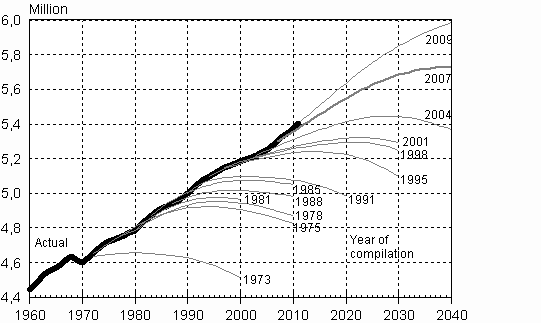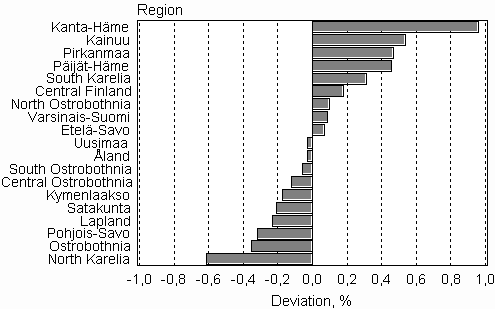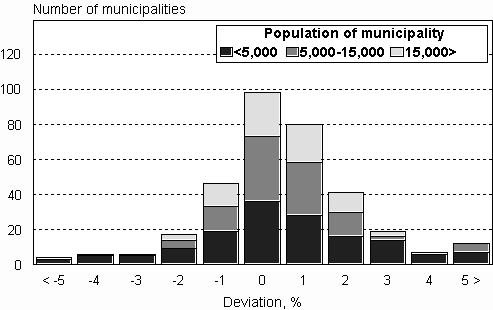Quality description: Population projection 2012–2060
- 1. Relevance of statistical information
- 2. Methodological description of survey
- 3. Correctness and accuracy of data
- 4. Timeliness and promptness of published data
- 5. Accessibility and transparency/clarity of data
- 6. Comparability of statistics
- 7. Coherence and consistency/uniformity
1. Relevance of statistical information
The basic population for this population projection has been population by municipality at the end of 2011 by 1-year age group according to gender. The projection was calculated by municipality and the figures for regions and the whole country were derived from municipality data by summing. The projection data can also be printed out using any other regional division as long as it is based on municipalities. In addition to data on population numbers, data are also available on the numbers of births, deaths and migrants according to the projection and the coefficients used in calculating the projection.
There are two calculations of the projection:
-
A calculation including migration (calculation 1), where account is taken of the effect of the birth rate, mortality, inter-municipal migration and migration on population development.
-
The self-sufficiency calculation (calculation 2) expresses what the future population development would be like without migration. The calculation takes only the impact of the birth rate and mortality on population development into account. The assumptions concerning birth rate and mortality are the same as in calculation 1. The numbers of births are, however, different in these calculations, as migrants assume the fertility of the receiving area in the calculation including migration.
The Central Statistical Office of Finland published the first population projection concerning Finland’s future population development in 1934. In 1956 the memorandum of the statistical committee set up in 1953 proposed that population projections should be compiled at regular intervals. The first projections related to the population development of the whole country. Preparation of regional projections started in the 1960s.
In 1973 the so-called population projection group established by the Prime Minister’s Office published its report “On arrangement of compilation of population projections” (“Väestöennusteiden laadinnan järjestäminen”, Valtioneuvoston kanslian julkaisuja 1973:1). In the report population projections were defined as follows: ”Population projections are calculations based on the past development of the factors influencing population development, which do not include population development planned by the compiler of the projection or any expressions of intent related to regional policy.”
According to the report, population projections “...indicate to decision-makers primarily what the development will lead to if social policy stays unchanged. Decision-makers have to assess the advisability of the development and consider on that basis whether the projections can be used as foundation for decisions on investments and on measurement of activities.”
2. Methodological description of survey
The population projection method used is a so-called demographic component model in which the future population number and structure are calculated by means of age-specific birth rate, mortality and migration coefficients. The coefficients are calculated on the basis of demographic statistics for the last few years. To decrease random variation of the coefficients they are calculated for several years and in addition, municipalities are grouped into birth rate, mortality and out-migration areas.
Birth rate
To calculate the number of births, municipalities are grouped into 88 fertility areas on the basis of the total fertility rate in the years 2007 to 2011. Municipalities with a population of 35,000 form their own fertility areas. Municipalities with a smaller population are combined into fertility areas with a population of roughly 30,000 to 60,000. Municipalities with small populations have been paired up with municipalities from anywhere in the country which have the same fertility rate. Previously the combinations were made within regions. When forming fertility areas, account has also been taken of age-specific fertility.
Age-specific fertility rates (women aged 14 to 50) have been calculated for the fertility areas for the years 2007 to 2011. Municipalities belonging to the same fertility area have identical fertility coefficients. In the projection the fertility rates have been kept constant throughout the projection period. For the whole country the average total fertility rate, that is, the average number of children born to each individual woman during her lifetime is 1.82.
Mortality
In order to calculate the number of deaths, 19 mortality areas have been formed. The five municipalities with the largest populations (at least 175,000 people) form their own mortality areas and smaller municipalities have been combined into mortality areas with populations ranging from 150,000 to 400,000. Municipalities have been grouped into mortality areas on the basis of age- and gender-standardised mortality for the years 2005 to 2011. Therefore, the mortality area of a municipality is not determined by its geographical location.
To reduce random variation, the mortality coefficients of the whole country are used in all mortality areas for persons aged 0 to 17 and 90 to 104. Area-specific coefficients are used for persons aged 18 to 89. Age-specific mortality rates have been calculated for the years 2007 to 2011. Coefficients by age and gender group for the annual change in mortality were derived by calculating how much mortality changed when comparing 1987 to 1991 with 2007 to 2011. Mortality was not inflated for any age group, however.
Migration
Municipalities are divided into 88 out-migration categories according to the out-migration propensity of those aged 0 to 6 and 16 to 44 from 2007 to 2011. Municipalities with a population of 35,000 form their own out-migration areas. Municipalities with a smaller population are combined into out-migration areas with populations ranging from 20,000 to 40,000. Municipalities with small populations have been paired up with municipalities from anywhere in the country which have the same out-migration propensity. Previously the combinations were made within regions. Age group-specific out-migration coefficients by gender for the out-migration areas were calculated on the basis of the years 2007 to 2011.
The whole country is divided into 15 migration major regions. Migration major regions are areas with populations of at least 100,000 formed around large regional centres (excl. Uusimaa and Åland). A municipality’s major migration region is determined by the regional centre or municipalities adjacent to a regional centre to which the municipality has had the most out-migration during 2007 to 2011. More migration areas have been formed into Southern Finland, because the population and migration numbers in the area require smaller area units.
In the population projection, migration between major migration regions is calculated with migration probabilities. First the total number of out-migrants from the major migration region is calculated by summing the number of out-migrants in the municipalities belonging to the major migration region. Then migration probabilities are used to calculate the proportion of the out-migrants who stay within their own major migration region and the proportion of out-migrants who go to other major migration regions. Age group-specific migration probabilities by gender for major migration regions were calculated on the basis of the years 2007 to 2011.
In-migration proportions have been calculated for municipalities for each age and gender group (a) for the migrants who stay in their own major migration region, (b) migrants from other major migration regions and (c) migrants from abroad into the major migration region. The proportions were calculated from the sum of the in-migrations in the municipality’s major migration area. In-migration proportions of the migrants from the municipality’s own major migration region and from other major migration regions were calculated on the basis of the years 2007 to 2011 and for the migrants from abroad on the basis of the years 2007 to 2011. All migration coefficients and in-migration proportions have been kept constant throughout the projection period.
In the calculation containing migration, the net immigration for the whole country is assumed to be 17,000 persons throughout the entire projection period. Net immigration is obtained by adding the assumed net immigration to the emigration for the whole country. The age distribution of immigration was calculated on the basis of immigration during 2007 to 2011. Immigration is divided into the major migration regions on the basis of the immigration proportion coefficient of each region. The immigration proportion of the major migration regions of the immigration of the whole country was calculated by age group and gender on the basis of the years 2007 to 2011. Municipalities’ immigration was calculated from the sum of immigration to their own major region by using the in-migration proportion coefficient.
The assumptions of the population projection were discussed by a broad-based expert group.
3. Correctness and accuracy of data
Figure 1 presents the population for the whole country according to Statistics Finland's population projections starting from the 1973 projection. With a few exceptions, the population of the new projection has been higher than previously expected, when the actual population development has exceeded the projection. The primary reason for the previous projections remaining below the real development is that immigration gain is assumed only for the first few years, after which net immigration is presumed to be zero. In addition, in previous projections the lowering of mortality is thought to stop after a few decades.
Figure 1. Population of the whole country in Statistics Finland's population projections by municipality for 1973 to 2009

In Table A the figures of the 2009 projection are compared with the actual figures in the first three years of the projection period. In these years the forecasts for the numbers of births and net immigration were quite accurate but number of deaths was greater than assumed in the projection.
Table A. Deviations of the population projection for the year 2009 from the actual figures in 2009 to 2011
| Comparison | Year | |||
| 2009 | 2010 | 2011 | ||
| Population 31 Dec | Projection | 5 352 208 | 5 378 165 | 5 404 240 |
| Actual | 5 351 427 | 5 375 276 | 5 401 267 | |
| Deviation | 781 | 2 889 | 2 973 | |
| Population change | Projection | 25 894 | 25 957 | 26 075 |
| Actual | 25 113 | 23 849 | 25 991 | |
| Deviation | 781 | 2 108 | 84 | |
| Births | Projection | 60 013 | 60 382 | 60 750 |
| Actual | 60 430 | 60 980 | 59 961 | |
| Deviation | -417 | -598 | 789 | |
| Deaths | Projection | 49 128 | 49 405 | 49 664 |
| Actual | 49 883 | 50 887 | 50 585 | |
| Deviation | -755 | -1 482 | -921 | |
| Net immigration | Projection | 15 000 | 15 000 | 15 000 |
| Actual | 14 548 | 13 731 | 16 821 | |
| Deviation | 452 | 1 269 | -1 821 | |
| Total fertility rate | Projection | 1,850 | 1,850 | 1,850 |
| Actual | 1,864 | 1,870 | 1,827 | |
| Deviation | -0,014 | -0,020 | 0,023 | |
| Life expectancy at birth, males | Projection | 76,61 | 76,90 | 77,18 |
| Actual | 76,48 | 76,71 | 77,17 | |
| Deviation | 0,13 | 0,19 | 0,01 | |
| Life expectancy at birth, females | Projection | 83,28 | 83,50 | 83,71 |
| Actual | 83,14 | 83,23 | 83,53 | |
| Deviation | 0,14 | 0,27 | 0,18 | |
| Life expectancy at age of 65, males | Projection | 17,44 | 17,61 | 17,80 |
| Actual | 17,16 | 17,30 | 17,55 | |
| Deviation | 0,28 | 0,31 | 0,25 | |
| Life expectancy at age of 65, females | Projection | 21,36 | 21,53 | 21,71 |
| Actual | 21,19 | 21,16 | 21,37 | |
| Deviation | 0,17 | 0,37 | 0,34 | |
Figure 2 presents the relative deviations of the regions’ projected population figures from the actual ones at the end of the third projection year.
Figure 2. Deviations of projected population figures by region in 2009 from the actual figures at the end of 2011

Figure 3 illustrates the deviations of municipalities’ projected population figures from the actual ones on the third projection year in municipalities of different sizes. The relative deviations of the projections from the actual figures are usually the greater the smaller the area and the more distant future they concern.
Figure 3. Deviations of projected population figures by municipality in 2009 from the actual figures on 31 December 2011

Municipal projections should be compiled for all municipalities with the same principles. It would be impossible to treat municipalities ”individually”, and therefore there have always been and will always be cases where e.g. the calculation period of the projection coefficients has somehow been exceptional for a municipality, which causes the projection to differ from the trend development in either direction.
The projection deviations for small municipalities are primarily due to their projection coefficients not corresponding to the actual level of out-migration, in-migration, fertility or mortality. Small municipalities must be combined into larger entities in order to reduce random variation.
In previous population projections the whole country was divided into four mortality areas. The number of mortality areas used now is much higher. The number of mortality areas has been increased so that regional differences in the level can better be taken into account. The population projection by municipality has always had some over-mortality. In order to reduce random variation, mortality coefficients have been calculated for a longer period and mortality coefficients for the whole country have been used for certain age groups (0 to 17 and 90 to 104+).
4. Timeliness and promptness of published data
Statistics Finland has prepared population projections by municipality at intervals of roughly three years. In the intervening years, projection calculations were made concerning the whole country on the basis of various assumptions, e.g. the low, average and high alternative. In recent years alternative calculations have been made mainly only as chargeable assignments, in which case the calculations have been based on the assumptions specified by the customer.
In connection with the 1998 projection a so-called stochastic forecast was calculated for the whole country with the PEP software (Program for Error Propagation) developed at the University of Joensuu. In it the population change components vary like they have varied in the past, and from the produced projection database e.g. the range of some statistical information can be derived with the desired probability. (For further information, see Juha M. Alho: A Stochastic Forecast of the Population of Finland. Katsauksia 1998:4).
The 2012 projection by municipality extends to the year 2060. It has been published by region up to the year 2040.
5. Accessibility and transparency/clarity of data
Up to 1972, population projections by municipality were published in the ”Tilastollisia tiedonantoja” series, then until 1985 in the “Tilastotiedotus VÄ” series and after that in the OSF Population series. Municipalities’ projected figures by age group were published as a separate volume of the 1969 projection, while age group data by municipality from later projections were available as photocopies. In the 1990s the data were mainly supplied as Excel tables. Previous projection files by municipality were not retained. Data on the population projections made in 2001, 2004, 2007 and 2009 are available in electronic format.
Data from the latest projection are available free of charge from the PxWeb StatFin service on the Internet at http://pxweb2.stat.fi/database/StatFin/vrm/vaenn/vaenn_en.asp
6. Comparability of statistics
Statistics Finland’s population projections are long-term projections. Therefore, they do not always give a reliable picture of e.g. the number of births or deaths in the coming years. Since the 1970s the birth rate has fluctuated up and down so that the total fertility rate has varied between 1.50 (1973) and 1.87 (2010). In population projections fertility has been kept constant at some average or initial level, because it would be impossible to guess the turning points in development. Likewise, mortality has fallen quickly at times and slowly at others. In the projections, the change coefficients for mortality have been calculated for 20–year periods so that they would include periods of both quick and slower lowering.
When comparing different projections, differences in the projection assumptions should be taken into account. Many municipalities prepare their own population projections, whose assumptions may deviate greatly from those used in Statistics Finland’s projections. In addition to Statistics Finland, population projections concerning the whole of Finland are produced by e.g. Eurostat and the UN.
7. Coherence and consistency/uniformity
In Statistics Finland’s population projections, the population figures for each year refer to the situation on 31 December. In the projections by Eurostat and many municipalities, the figures refer to the situation on 1 January. In the UN projections, the figures represent the situation in the middle of the year.
Source: Population Statistics 2012, Statistics Finland
Inquiries: Markus Rapo 09 1734 3238, vaesto.tilasto@stat.fi
Director in charge: Jari Tarkoma
Updated 28.9.2012
Official Statistics of Finland (OSF):
Population projection [e-publication].
ISSN=1798-5153. 2012,
Quality description: Population projection 2012–2060
. Helsinki: Statistics Finland [referred: 21.12.2025].
Access method: http://stat.fi/til/vaenn/2012/vaenn_2012_2012-09-28_laa_001_en.html

